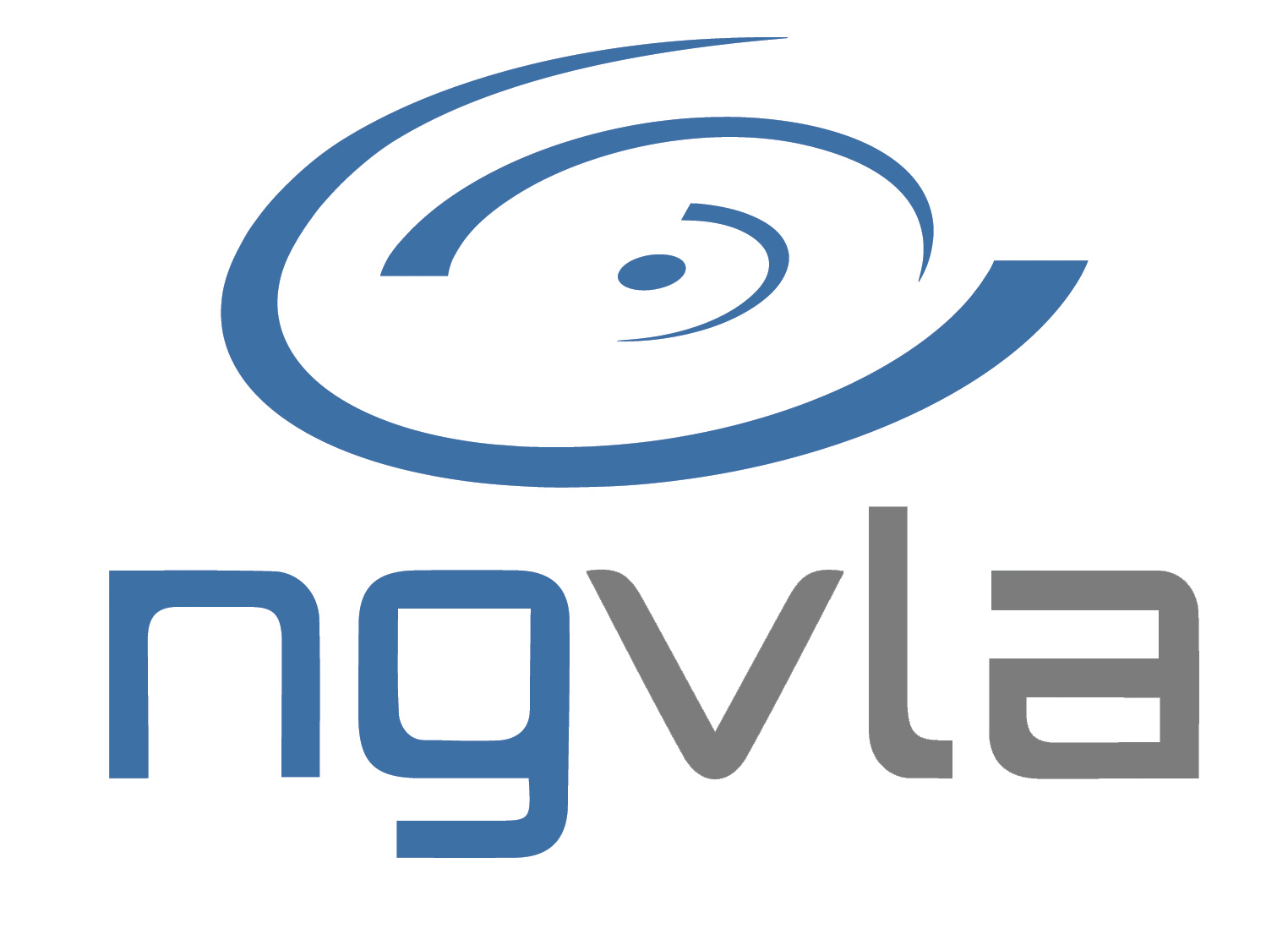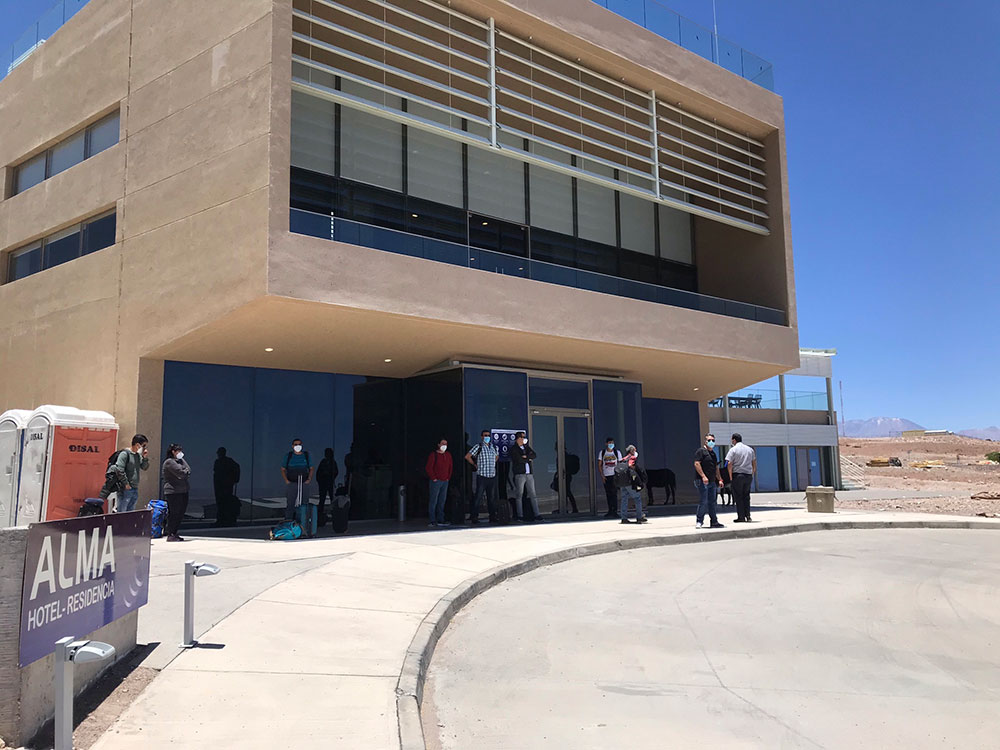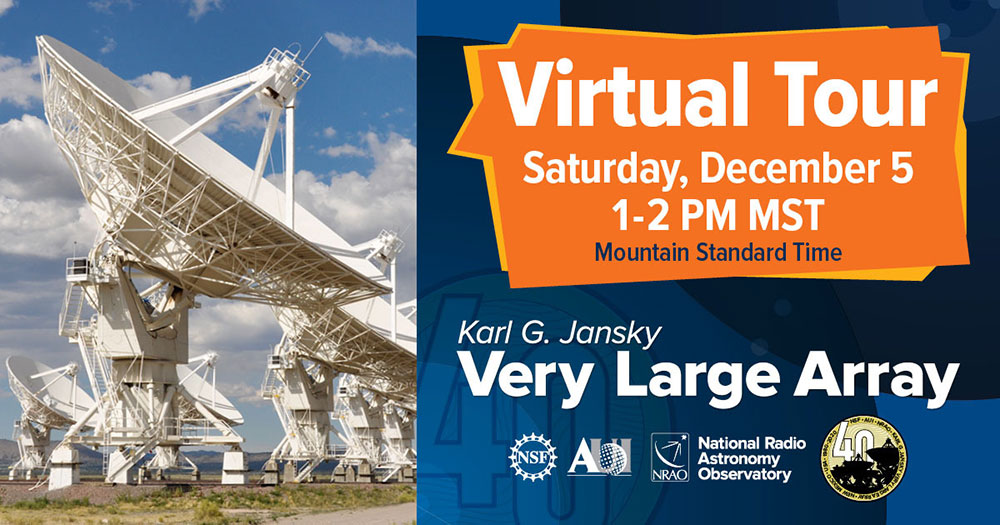NRAO eNews
Volume Vol#, Issue Iss#
Day# Month# Year#
NRAO eNews
Volume Vol#, Issue Iss# • Day# Month# Year#

Upcoming Events

NRAO Community Day
Dec 15, 2020 | Virtual

ngVLA Town Hall
Dec 16, 2021 | Virtual

NRAO Community Day
Jan 8, 2021 | Virtual

NRAO Town Hall
Jan 13, 2021 | Virtual AAS Meeting

New Views of Galaxy Formation and Evolution
Jan 14, 2021 | Virtual AAS Meeting
Virtual NRAO Community Day Events

The National Radio Astronomy Observatory (NRAO) is pleased to announce two virtual Community Day Events focused on Very Large Array (VLA) and Very Long Baseline Array (VLBA) proposal preparation and telescope time allocation.
The first Community Day Event will be held Tuesday, 15 December 2020, 9 a.m.–2 p.m. MST, and the second Community Day Event will be held Friday, 8 January 2021, 1 p.m.–6 p.m. MST. Except for the dates and times, the programs of the two events are identical. There is no registration fee to participate in these events, but registration is required to obtain access to the live lectures and discussions. Each event will be limited to 50 participants, so please register early to either of them to reserve your spot.
Registration forms, and relevant deadlines are now available at the websites for both the 15 December and 8 January events.
ngVLA Project News

Recent ngVLA Progress
For FY2021, the National Science Foundation (NSF) continues to support the design and development effort through its funding of the next generation Very Large Array (ngVLA) cooperative agreement. Approximately $10M USD has been made available to continue work on key ngVLA subsystems including antennas, electronics and computing, a marked increase over the $4M allocated in FY2020 and the $11M provided over FY2018–19. Working closely with the NSF, the ngVLA Project Office is developing plans for the next three years of design and development, leading to a shovel-ready project mid-decade.
In collaboration with industry and our international partners, including the National Research Council Canada, the Project has conducted five conceptual design studies for the ngVLA 18m antenna. These studies have resulted in four alternative concepts that meet the key requirements while employing differing innovative technical solutions.
As part of the conceptual design downselect, the Project has released a request for proposals for the final design and prototype of the 18m antenna. Proposals are due early December, with an anticipated downselect and award in the first quarter 2021. The proposals will be evaluated on a best-value basis, considering the estimated and modeled performance of the antenna concept to the full Project scientific and operational requirements, the costs of the design and prototype effort, and the anticipated total lifecycle costs for the Project.
The Project has released a notional Envelope Observing Program, a prediction of how the community might use the facility during a typical year of full science observations. The Program adopts values for the availability of science time and antennas that are more taxing than the Project's goals. It thus represents an upper envelope on what might actually be demanded from the facility. The Program will be used to inform studies of computing loads and design options.
ngVLA Community Studies Program Call for Proposals
As the ngVLA Project heads towards the completion of its Conceptual Design, the NRAO is pleased to announce this call for proposals, the fourth ngVLA Community Studies Program. The proposal receipt deadline is 15 January 2021, 23:59 EST.
These Community Studies are designed to further develop the most pressing science questions that can be addressed by the next-generation centimeter- and millimeter-wavelength radio telescope, the ngVLA. As with previous rounds, we expect that all accepted Community Studies will document their findings as part of a peer-refereed journal article or ngVLA memo, and present their progress/final results at an appropriate science meeting, such as the January 2022 American Astronomical Society meeting. Consequently, we anticipate funding most formally accepted proposals at a modest level to offset possible travel expenses, as well as for page charges from publications expected to result from the study. We also expect to fund a small number of these Community Studies at a more significant level (up to $30,000 per award) through the ngVLA Community Studies Grants (CSGs) program. A full description of the program and a list of past awards is online.
ngVLA Science Support Research Job Opening
The ngVLA Project is hiring a Science Support Research Associate. The successful candidate will be an essential part of the ngVLA effort as the Project develops its Conceptual Design for consideration as an NSF Major Research Equipment and Facilities Construction candidate. The primary focus of this position will be to continue the development of the science operations concept for the facility, derive associated requirements for the science-facing software systems, and support the development of detailed use cases for system simulations and tests, in addition to having their own independent research time. Please apply online. The deadline for receipt of applications is 15 December 2020, 23:59 EST. For questions about the position, please contact Eric Murphy.
ngVLA Town Hall
The ngVLA Project Office invites you to join a Town Hall on Wednesday, 16 December 2020 at 1:00 p.m. EST via Zoom that will update the community regarding the ngVLA Project progress and status. This forum will describe: (a) the next round of ngVLA Community Studies, a funding opportunity for the community to further develop the most compelling ngVLA science questions; (b) recent key Project technical developments; and (c) the FY2021 schedule and conceptual design milestones. There will be ample time for discussion. Please register for the ngVLA Town Hall.
New Views of Galaxy Formation and Evolution
The NRAO and the ngVLA Project will convene a virtual Special Session titled New Views of Galaxy Formation and Evolution on 14 January 2021 at the American Astronomical Society (AAS) meeting.
Sensitive ground- and space-based astronomical facilities are pushing the detection of galaxies well into the Epoch of Reionization, less than 1 Gyr after the Big Bang. Such detections are allowing us to begin piecing together a picture for how and when the first galaxies formed, along with the physical processes driving their evolution into the mature systems that we observe in the local Universe. This AAS Special Session will highlight recent scientific breakthroughs enabled by current investigations using large optical/IR, submillimeter and millimeter, and radio facilities; describe planned improvements for ground- and space-based facilities; discuss major scientific leaps likely to result from next-generation facilities across the electromagnetic spectrum; and review the highest-priority goals that will be accomplished by the state-of-the-art observatories commissioned in the next decade.
This virtual AAS event will feature a session of invited oral presentations and an associated iPoster session with contributed presentations. Confirmed speakers include: Mark Dickinson (NOIRLab), Linda Tacconi (Max Planck Institute for Extraterrestrial Physics), Justin Spilker (University of Texas), Xiaohui Fan (University of Arizona), Chris Willott (Herzberg Astrophysics), and Rachel Sommerville (Flatiron Institute). We anticipate that the iPoster session will draw 20+ contributions.
Offset Supermassive Black Holes with the ngVLA

credit
Angular offset versus line-of-sight velocity for recoiling AGN, assuming the spin axes of the progenitor SMBHs have random (left), bimodal (center) and close (right) alignments (Blecha et al. 2016, 2018).
[click to enlarge]
Supermassive black holes (SMBHs) are commonly understood to inhabit the centers of nearly all galaxies. When actively accreting gas, they are called active galactic nuclei (AGN). This nomenclature reflects their nominal location, but SMBHs are not always centrally located.
SMBHs that form binaries or triples during galaxy mergers can produce gravitational-wave (GW) recoil and gravitational slingshot kicks, which can displace SMBHs or even eject them from galaxies entirely (Campanelli et al. 2007, Gualandris & Merrit 2008, Blecha & Loeb 2008, Bonetti et al. 2016). Such systems are more than a mere curiosity, as displaced SMBHs will affect the subsequent GW event rate and introduce scatter into BH-bulge correlations (Volonteri 2007, Blecha et al. 2011, Sijacki et al. 2011). Confirmed offset AGN would also constrain the evolution of binary and merging SMBHs, including binary masses and spins in the final stages of the merger.
Unambiguous confirmation of recoiling AGN has proven tricky with existing observations for a number of reasons, including the limited resolution and sensitivity of infrared and optical telescopes (e.g., Komossa et al. 2008, Civano et al. 2012, Chaberge et al. 2017). The ngVLA will be able to resolve spatial offsets at sub-parsec scales and will be uniquely sensitive to offset AGN that are still embedded in dust-obscured nuclei. Theoretical models predict that dozens of spatially-offset GW recoiling AGN could be detected with the ngVLA in the nearby universe (Blecha et al. 2016, 2018). Moreover, the ngVLA offers the entirely new possibility of measuring the proper motions of rapidly-recoiling AGN in nearby systems. A large search of nearby galaxies with the ngVLA could yield several such sources, and an ngVLA detection of a displaced AGN with a proper motion measurement would constitute the gold standard for a confirmed recoiling AGN.
The angular resolution, sensitivity, and broad frequency coverage of the ngVLA will provide unparalleled opportunities for identifying offset AGN that cannot be confirmed with other observations alone. Such observations will constrain the mass and spin evolution of SMBHs in mergers as well as the GW source population (see figure). The long baseline component of ngVLA will allow feasible measurements of proper motions of 1000 km/sec at 200 Mpc distances, within which we expect there to be about 10 such ejected AGN. A 100-hour ngVLA survey, targeting the large galaxies within 200 Mpc, could detect about half of these objects. No other existing or proposed facility has the combination of sensitivity, angular resolution, and field-of-view needed to have a reasonable chance to measure the proper motions of any of these objects in a blind search. ngVLA searches for recoiling AGN have strong synergy other multi-messenger observations, and they are a natural complement to searches for binary SMBHs with the ngVLA. The dynamical evolution of SMBHs in merging galaxies is a pressing open question in the dawn of low-frequency GW astronomy, and ngVLA studies of offset AGN will be a key component of the multi-messenger campaign to unravel this mystery.
This article continues a regular feature intended to highlight contributions to the ngVLA Science Book. We are especially interested in showcasing work done by early-career researchers. Anyone wishing to volunteer to author a feature should contact Joan Wrobel.
ALMA Program News

ALMA personnel continue to work turno shifts at the OSF continuing progress toward ALMA's restart; here the first group awaits transport home.
[click to enlarge]
ALMA Science Sustainability
The schedule for the Cycle 8 Call for North American Development Project Proposals was delayed by six months due to COVID-19.
The ALMA Development Projects Implementation Plan will be available for review and describes the fundamental processes for project proposal and review. The call for proposals will be open to the North American (NA) ALMA Operations Partnership, which is defined as the community of astronomers and scientists in related fields from NA ALMA partner countries. Projects will be funded for Cycle 8 in an integrated, multi-year award. Priority will be given to those Projects which align with the ALMA Development Roadmap (ALMA Memo 612). Topics of particular interest to the NA ALMA Partnership include larger bandwidths and improved receiver sensitivity, such as would be provided by an upgraded correlator and receivers. Second Generation Correlator proposals must meet the specifications of the Correlator Working Group report, the first draft of which is expected by the proposal call date.
All proposals and resulting instrumentation must comply fully with ALMA standards for system interfaces, interoperability, and documentation. NRAO staff can help applicants develop plans or steer them toward relevant documentation, upon request and with sufficient notice.
The date of issue for the Call for Proposals will be 15 January 2021. Project execution can only begin after adjudication at the April 2022 ALMA Board Meeting.
If you are planning or even considering proposing in response to this Call, you must file a Notice of Intent before 28 February 2021. In contrast to previous Calls, submission of a Notice of Intent is mandatory.
Additional details will be released with the Call in January 2021. The deadline for receiving the proposals will be 15 April 2021.
Joint ALMA Observatory Return to Operations Status
The Observatory continues in the Operations Support Facility (OSF) Ramp-up phase commenced 21 October. Beginning 31 October, some staff began staying in the Residencia, where meal service recommenced a few days later. Work has focused on stabilizing water, power, sewage, and essential service for the 144 available rooms. The OSF Data Center, including relevant data bases, is being restored. Communication between the OSF and the Santiago Central Office occurs via microwave link. Restoration of services at the OSF continues ahead of schedule.
The fiber link is routed through the Array Operations Site (AOS). Its restoration awaits power availability at the AOS. The next major gate review for AOS re-opening occurs later in November. Restoration of array functionality will begin with the 12m array. Most staff at the Santiago Central Office (SCO) are working from home. SCO data replication will be restored soon. Production environments are available and should be imminently ready for testing.
Virtual VLA Tours Offered

If you have never visited the Jansky Very Large Array (VLA) in person, or you are keen to see it again, the STEAM Education Team is offering one of its monthly virtual tours on Saturday, 5 December 2020, 1 p.m. MST / 3 p.m. EST.
Enjoy a personal, in-depth look at this world-renowned radio telescope and the field of radio astronomy. The tour will include an introduction to the history and science of the Very Large Array, video segments that will transport the audience to parts of the Observatory otherwise off limits to the public, and an interview with one of the telescope operators. There will also be time for Q & A.
Registration via Zoom is required. More info is available on-line.
Recent Media Releases
|
VLA Sky Survey Reveals Newborn Jets in Distant Galaxies |
|
|
IMAGE RELEASE: Galaxies in the Perseus Cluster |
|
|
Catching a Radio Surprise |
|
|
Galaxies in the Infant Universe Were Surprisingly Mature |
From the Archives
Ellen Bouton

[click to enlarge]
About this month's photo: Thanksgiving is coming, but, sadly, few of us will be gathering this year around crowded tables with friends and relatives. This photo of a community supper in Green Bank in late 1960 honors food-filled gatherings enjoyed in the past and hoped for in the future. Sebastian von Hoerner is leaning forward on left, Cam Wade (dark shirt and rimmed glasses) and Mary Jane Wade (beside Cam, holding the coffee can) are on the right.
From the Archives is an ongoing series illustrating NRAO and U.S. radio astronomy history via images selected from our collections of individuals' and institutional papers. If readers have images they believe would be of interest to the Archives, please contact Ellen Bouton.

